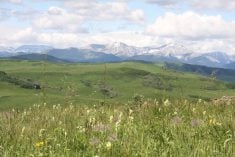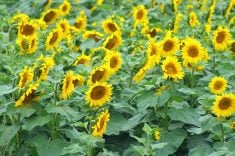ROSTHERN, Sask. – Spring training is under way for racehorses at Tom Gardipy Jr.’s farm in north-central Saskatchewan.
Cars and trucks dot the yard from the stables to the horse walker to the white-sided house. Handlers move swiftly between washing animals, cleaning stables and exercising horses.
Gardipy quietly tells his helpers what jobs are yet to be done this morning. Moments later, he will tell a phone caller which horse should go in what race.
At 40, he has trained horses for more than two decades. He was rewarded for his 25-win record last season with the leading trainer award for 2000 from the Horseman’s Benevolent and Protective Association of Saskatchewan.
Read Also

Gene editing digs deeper space in Canadian plant breeding
More Canadian research into crop variety development is incorporating gene editing, and one researcher notes that Canada’s regulatory approach to gene editing will help drive innovation
Spanish High Rise, trained by Gardipy, received the claimer of the year award, racking up five wins.
“Like anything else, you do something long enough, you get better at it,” he said.
The oldest of nine children, Gardipy, with his wife Cheryl, has five children ranging in age from five to 17. The youngest plays nearby this day, following his dad around the family’s Black Diamond Stables on the Beardy’s-Okemasis reserve.
Racehorses have been synonymous with Gardipys through four generations. Tall and slender, he jockeyed until he surpassed 125 pounds at age 16.
“I was sad to give it up,” said Gardipy, who started racing at age 10.
The lifestyle suits Gardipy, whose work
allows him to maintain close ties to his family and enjoy the outdoors and animals that include a goat, dogs, horses and 60 commercial cattle he raises with his father.
“I felt I knew enough about horses to succeed in it and it ran in my blood,” he said. Other job options were limited, as his formal schooling ended at Grade 8.
Ideal age
He begins his training regime with a good horse, preferably a three year old. Younger ones must be broken and are too immature to race, he said, noting horses can race from two until age 12.
Gardipy examines a horse’s record and conformation, checking how it stands and runs. His farrier skills come in handy in getting horses to stand as he feels they should.
“I take care of my horses just like they’re part of the family.”
Steve Tatarniuk of Marquis Downs in Saskatoon called Gardipy a good caretaker of horses who has a sixth sense about them.
“He’s sharp, even shrewd, and has got a keen eye for a horse,” he said.
The top jockey in Saskatchewan last year, Walter Ramos Jr., rode many of Gardipy’s mounts during his 73 wins in 2000.
Ramos called him a good trainer who conditions his animals well and “does not get too greedy. He runs them where they belong.”
Ramos said there must be trust between jockey and trainer to succeed, “trust that the horse will be ready to race and trust that the jockey will run a good race.”
He called Gardipy a good horseman and a “not pushy, not picky” easy-going person, saying that “in the type of business he’s in, that’s a virtue.”
Jockeys have the most dangerous job, but Gardipy did admit to a few hazards of his own, getting stepped on or kicked by a 455 kilogram animal.
As for the horses, leg injuries are the top problem in Thoroughbred racing. A shattered foot or ankle can be career ending or worse.
“It’s a low point for anyone in racing,” said Gardipy. He recalled when he had to take a favorite horse to the university’s vet clinic to be put down.
“It was the hardest thing I ever had to do,” he said. “It would have been inhumane to keep him alive.”
Gardipy, who supplements his income
driving a school bus, said it can get expensive buying proven horses, so he keeps his bids low.
“There is a chance the horse will not perform,” said Gardipy, who charges $15 a day to train a horse in Saskatchewan, and $20 at Winnipeg’s Assiniboia Downs.
“If you don’t know what you’re doing, you can lose money real fast. It can also make money real fast if you do things right.”
Instinct and experience account for knowing which horses are sprinters and which prefer distance races, he said. His strengths lie in high stakes races, he said. Doing well there allows him to race fewer horses less
often.
A trainer has to know when his athlete is peaking. “I can’t tell how, it just feels like he’s ready to run,” he said.
Bringing a horse down to a less competitive level is also necessary if it is struggling in races.
While winters are a time of healing and rest for the horses, spring is a time of
training.
Gardipy progressively builds their workouts from walking to running, having them train a minimum of 90 days before entering them in races.
His routines include morning training and grooming, followed by an afternoon siesta, then feeding and chores again after supper. He grows oats for his horses ,
supplementing a special feed blend with
vitamins.
With help from his extended family, Gardipy trains close to a dozen horses. He throws a few bets their way occasionally, but only if they are long shots.
The family tradition in horses seems destined to carry on through Gardipy’s nine-year-old daughter Jessica. Already involved and showing a keen interest in horses, Gardipy noted, “I see myself in Jessica sometimes.”














